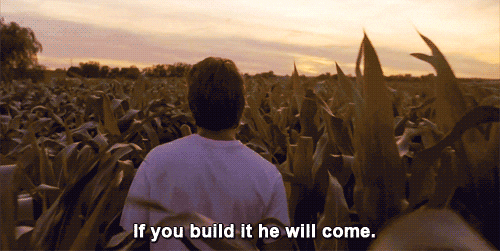In the movie “Field of Dreams,” Kevin Costner’s character, Ray, hears a voice that tells him, “If you build it, he will come.” He takes this as a sign to build a baseball field on his farm. He believes if he does, the ghosts of past baseball players will come to play ball.

Marketers (and founders) often make the same mistake. Believing if we built it, customers will come.
“If we write that blog post people will read.”
“If we shoot a video series people will watch.”
“If we record a podcast people will listen.“
Some marketers might even scoff at that thought. “We don’t believe that,“ they say. But belief isn’t what you think. It’s how you act.
And most marketers today have fallen for the false belief that simply by creating great content, building great products, or having a great website, those things will speak for themselves. Build it, and they will come.
But the reality is, you’re not only competing for market share, you’re competing for attention. And as much as we’d like to think our audience is waiting with bated breath for our next release, they most likely could not care less. Unless we give them a reason to care.
Customers have no clue what you’ve made until you show it to them. And then keep showing it to them over and over again. All of this building, creating, and producing is useless unless your audience knows about it.
And this is why content distribution is key to scaling your business.
The typical distribution plan
According to a B2B Content Marketing Survey, only 39% of B2B content programs have a documented content strategy. My guess is that number plummets even further if you asked about a documented content distribution strategy. It’s probably close to zero.
(BTW if you have a documented distribution strategy, send it to me. I’d love to see it.)
That means most companies are creating hundreds of blogs, podcasts, and videos every single year without an actual strategy to get that in front of their audience. And they have no ability to scale other than keep on creating new content.
Let’s break down a few of the major “buckets” companies use to promote and distribute their content and how you can start building distribution into the core of your content strategy.
Bucket 1: 100%
SEO
SEO is helpful, but it’s not everything.
SEO (search engine optimization) is just another distribution channel. I cut my teeth in content marketing in SEO. And I love the long-term gains that can come from investing it in.
But for a lot of early-stage companies, SEO alone won’t help you grow as fast as you need to.
The problem with a 100% SEO strategy is three-fold:
- It’s like investing in the stock market. Gains typically compound over time rather than provide an immediate boost.
- You’re at the mercy of Google (or YouTube) to get in front of your audience.
- You’re only getting in front of an audience that’s actively looking for what you’re offering.

This means if you create a piece of thought leadership content with SEO as your main driver, it’s basically dead in the water. It’s most likely a unique idea that people aren’t actively searching for and even if they were it’s going to take way too much time for Google to start ranking it.
And because you haven’t built up other channels for distribution, your audience barely even knows that content exists. It stays locked up in content jail with no hope of freedom.
Bucket 2: Renting channels
Many of us are familiar with rented channels, even if we wouldn’t all call them that. These are places like social media platforms, forums, etc. that allow you to “rent“ space to distribute your thoughts and ideas.
These platforms allow you to build an engaged audience where people are already hanging out every single day. The pro is you don’t have to wait for someone to go find you, you can get in front of them immediately. The con is many of these algorithm-based platforms can change on a whim. Leaving you stuck.
But at the very least, these channels are a great place to start building relationships and get the word out.
It’s almost the opposite of the SEO approach. You can instantly get your content in front of an audience, but the lifespan of that content can only be a few days or a few minutes in some cases.

And you have to constantly feed the beast in order to gain traction.
Bucket 3: Owning your platform
The ultimate way to distribute content is to own your platform. Typically this means a website, newsletter, or community where you have full control of your content and the experience of your audience.
You want to create an ecosystem where your audience is so bought into what you’re doing and the content you’re creating that they’re willing to subscribe to your platform to join in.

This takes longer to build up (no one starts with a full-fledged community or subscriber base) but these owned assets carry the most value.
Unlike the rented channels, you’ll have the freedom to experiment, create, and publish any type of content you want.
The Distribution First approach
Now you know the typical distribution strategies companies lean on. The next step is to put a system in place around your content distribution. This is what I call the Distribution First approach.
Most companies create content and move on to the next thing. It puts marketers into a never-ending cycle of creation. And because we get so focused on what’s next we forget to promote what we just spent tons of time researching, creating, and publishing.
The Distribution First approach flips content marketing on its head. It forces you to plan out exactly where your content is going before you start creating. It builds distribution into the process rather than leaving it as something you tack on at the end or completely ignore.
The first step in documenting your distribution strategy is to write down your Distribution Plan. Actually write it down. Get out a notebook and start filling these things out. By the end of this, you’ll be in the top 1% of marketers or founders who actually have a written distribution plan.
Step 1: Choose your channel(s)
Unless you have a massive team with a massive budget you can’t be everywhere at once. Every single channel is unique. So, I suggest choosing a few channels from the buckets above (SEO, rented channels, owned platform).

This could look like:
- SEO + Twitter
- Email Newsletter + LinkedIn
- Community + Youtube
The idea is to pick channels that you can execute at a high level and that give you both short and long-term growth.
Step 2: Choose your themes
A key part of content distribution is keeping everything on message from the start. If you distribute bad content it’s not going to solve anything. It’s going to amplify the bad content.
So, before you spend a ton of time creating a new piece of content make sure you can answer these two questions:
- What do we want to be known for?
- What topics tie back to my product or service?
If you get your themes right at the top, everything else you distribute will flow from it. And ultimately lead to more awareness of the problems you solve and the products you offer.
Step 3: Audit your existing content
Now that you have your channels and themes, go back and audit your existing content into those buckets. This allows you to narrow down what content is worth sharing and gives you something you can immediately start repurposing and distributing back out to your audience.
You might even find that you have tons of great stuff sitting there that can fuel your entire distribution strategy.
Step 4: Grade your content
One of the common hangups with content distribution is that every piece of content you create needs the same distribution plan. But it’s not one-size-fits-all.
The effort you put into a product webinar should be completely different from what you put into a massive original research report.
If you write a great bottom-funnel piece of content that compares you to a competitor, it might be great for Google, but terrible for a Twitter thread. It might be great for an ad but awful as a YouTube Short. You don’t want an umbrella distribution strategy that covers every piece of content.
The solution is to grade your content by impact prior to creating it. Here are a few categories you can use to grade your content:
- Relevance
- Quality
- Originality
- Impact

This can be quite subjective but it’s important to know what distribution looks like for an “A” piece of content like a podcast episode compared to a “C” piece of content like a press release or funding announcement.
Different content needs different distribution.
Step 5: Measure, optimize, and repurpose
If you want long-term results you have to measure your content, optimize it, and constantly repurpose it.
Take the content you’re already distributing and look at where you’re seeing the most traction. How you measure distribution will depend greatly on where you distribute your content. Twitter and LinkedIn are going to give me dramatically different metrics to look at compared to email or YouTube.
Then adjust the distribution plan for future pieces of content according to what trends you’re seeing.
Don’t forget about repurposing either. This is one of the biggest hacks for content distribution. You can take one piece of content and spin it into multiple pieces. For example, if you have a popular template or framework you can take that and make it into a long-form article, a podcast episode, a video series, and a ton of LinkedIn posts. All with their own unique angle and purpose.
Taking control of distribution
Let’s face it. Distribution is hard. It’s no wonder most marketers and founders shut their eyes and hope for the best rather than build a plan.
But if you lean on the Distribution First approach you put yourself in a position to systematically build out a content discovery system that will help you drive growth.
This approach will give you a process that helps you build your brand and lets you consistently invest your resources into the content that matters most.
Justin Simon | About the Author
Owner, justinsimon.co
Justin consults, advises, and executes content distribution and repurposing strategies for growing SaaS companies and founders. He is the host of the Distribution First podcast and creator of Content Repurposing Roadmap. Follow him on LinkedIn and Twitter.



